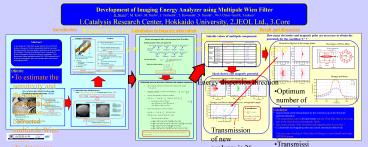Calculation to Improve aberration PowerPoint PPT Presentation
Title: Calculation to Improve aberration
1
Introduction
Result and discussion
Calculation to Improve aberration
How many electrodes and magnetic poles are
necessary to obtain the potentials for the
condition 'C' ?
Suitable values of multipole components
Present Wien filter
New Wien filter
Aberration figures at the image plane
The shape of Wien filter
Image plane
Object plane
- Objective
- To estimate the sensitivity and the energy
resolution of aberration-corrected multipole Wien
filter. - To determine the number of electrodes and
magnetic poles.
Ideal electric and magnetic potential
Energy spectrum
Aberration figures at the image plane
Energy dispersion direction
Relationship between aberration coefficients and
multipole components
- Wien condtion Selection of electron with
certain kinetic energy - ?
- Stigmatic condition Correction of astigmatism ?
- Second order aberration correction condition
- Second order aberration coefficients
- Third order aberration correction condition
- Third order aberration coefficients
- Optimum number of electrodes and magnetic poles
is 12. - Transmission of new analyzer is 19 times better
than that of previous one if shape of analyzer is
included in our calculation.
Energy resolution dependence on acceptance angle
- Conclusion
- Improvement of the transmittance by the
correction up to the 3rd-order aperture
aberration - ? The transmittance can be 26 times better than
the Wien filter that we are using now in the
ideal electric and magnetic fields. - How many number of the electrodes and magnetic
poles do we need ? - ? 12 electrodes and magnetic poles can correct
aberrations effectively. - This new type of multipole Wien filter will
bring us a user-friendly and bright EXPEEM system.
Transmission of new analyzer is 26 times better
than that of present one.
Necessary to eliminate aberration coefficients
using multipole components
PowerShow.com is a leading presentation sharing website. It has millions of presentations already uploaded and available with 1,000s more being uploaded by its users every day. Whatever your area of interest, here you’ll be able to find and view presentations you’ll love and possibly download. And, best of all, it is completely free and easy to use.
You might even have a presentation you’d like to share with others. If so, just upload it to PowerShow.com. We’ll convert it to an HTML5 slideshow that includes all the media types you’ve already added: audio, video, music, pictures, animations and transition effects. Then you can share it with your target audience as well as PowerShow.com’s millions of monthly visitors. And, again, it’s all free.
About the Developers
PowerShow.com is brought to you by CrystalGraphics, the award-winning developer and market-leading publisher of rich-media enhancement products for presentations. Our product offerings include millions of PowerPoint templates, diagrams, animated 3D characters and more.

